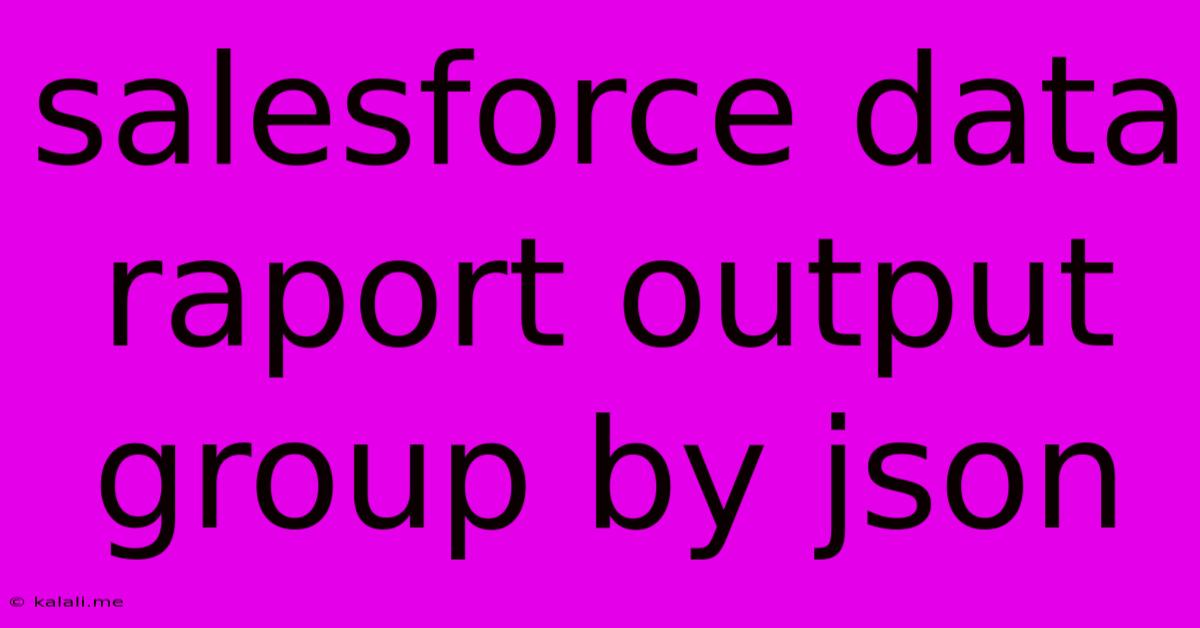Salesforce Data Raport Output Group By Json
Kalali
May 23, 2025 · 3 min read

Table of Contents
Salesforce Data Export: Grouping and Formatting with JSON for Powerful Reporting
Salesforce holds a wealth of data, but raw exports often lack the structure needed for insightful analysis and reporting. This article explores how to leverage Salesforce's capabilities to generate custom data reports, specifically focusing on grouping data and outputting it in JSON format for easy consumption by other applications or for creating dynamic visualizations. This method allows for cleaner, more organized data, perfect for dashboards, external integrations, and advanced analytics.
Why Choose JSON for Data Export?
JSON (JavaScript Object Notation) is a lightweight, text-based data-interchange format widely used for its readability and ease of parsing by various programming languages. Its hierarchical structure makes it ideal for representing complex data relationships, making it a superior alternative to CSV or other less structured formats when dealing with grouped Salesforce data. Choosing JSON simplifies data integration with other systems and enables the creation of sophisticated reporting applications.
Achieving Grouped JSON Output from Salesforce
There's no single "button" in Salesforce to directly export grouped data as JSON. However, we can achieve this through a combination of techniques:
1. Leveraging SOQL's GROUP BY Clause
The foundation of grouped data lies within Salesforce Object Query Language (SOQL). The GROUP BY clause allows you to aggregate data based on specified fields. For instance, to group opportunities by stage and count the number of opportunities in each stage:
SELECT StageName, COUNT(Id) FROM Opportunity GROUP BY StageName
This query will return a result set with two columns: StageName and COUNT(Id). The COUNT(Id) represents the number of opportunities in each StageName group.
2. Apex for Data Manipulation and JSON Serialization
While SOQL handles the grouping, Apex is crucial for manipulating the query results and formatting them as JSON. Apex, Salesforce's proprietary programming language, allows you to perform complex data transformations and serialize the results into a JSON string. Here's a simplified example of an Apex class:
public class OpportunityReportGenerator {
@AuraEnabled(cacheable=true)
public static String getOpportunitiesByStage() {
AggregateResult[] results = [SELECT StageName, COUNT(Id) FROM Opportunity GROUP BY StageName];
List> opportunityData = new List>();
for (AggregateResult ar : results) {
Map data = new Map();
data.put('StageName', ar.get('StageName'));
data.put('OpportunityCount', ar.get('expr0')); // expr0 refers to COUNT(Id)
opportunityData.add(data);
}
return JSON.serialize(opportunityData);
}
}
This Apex class queries Salesforce, processes the AggregateResult, and transforms the data into a JSON-friendly format before serializing it using JSON.serialize(). This JSON string can then be accessed by your application or dashboard.
3. Utilizing Visualforce or Lightning Web Components (LWC) for Display
Visualforce pages or LWCs can be used to call the Apex class and display the resulting JSON data. You could use JavaScript libraries like D3.js or Chart.js to render dynamic charts and graphs based on this JSON data, providing highly interactive and insightful reports.
Advanced Considerations:
- Handling Null Values: Account for potential null values in your SOQL query and Apex processing to avoid errors.
- Error Handling: Implement robust error handling in your Apex code to manage exceptions gracefully.
- Large Datasets: For very large datasets, consider using asynchronous Apex or batchable Apex to avoid governor limits.
- Data Security: Implement appropriate security measures to control access to the data and Apex classes.
- Complex Grouping: You can extend the
GROUP BYclause to include multiple fields, enabling more granular grouping. For example:SELECT Account.Name, StageName, COUNT(Id) FROM Opportunity GROUP BY Account.Name, StageName.
By combining the power of SOQL's GROUP BY clause with the flexibility of Apex and JSON serialization, you can create highly customized and effective data reports directly from your Salesforce data. This approach facilitates seamless integration with external tools and enhances the overall value of your Salesforce investment. Remember to adjust the SOQL query and Apex code to match your specific data model and reporting requirements.
Latest Posts
Latest Posts
-
How Many Cups Are In 3 Quarts Of Water
Jun 30, 2025
-
25 Cents A Minute For An Hour
Jun 30, 2025
-
In Music What Does Allegro Mean Math Answer Key Pdf
Jun 30, 2025
-
What Is 1 5 Of A Tablespoon
Jun 30, 2025
-
How Long Does It Take To Drive Through Illinois
Jun 30, 2025
Related Post
Thank you for visiting our website which covers about Salesforce Data Raport Output Group By Json . We hope the information provided has been useful to you. Feel free to contact us if you have any questions or need further assistance. See you next time and don't miss to bookmark.